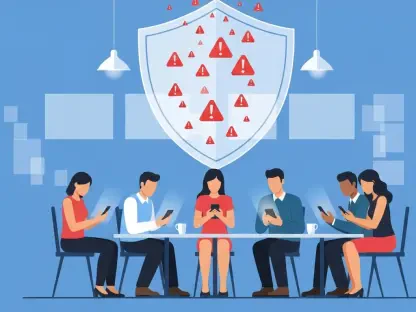Small to medium-sized enterprises (SMEs) often face unique challenges when it comes to cybersecurity. Limited budgets and resources mean that these businesses must rely heavily on employee commitment and hard work to maintain productivity and efficiency. Unfortunately, this often results in cybersecurity policies being pushed to the backburner, leaving SMEs vulnerable to cyber threats. One critical area that is frequently overlooked is mobile security. Given the growing reliance on mobile devices for work-related tasks, both onsite and remotely, the need for robust mobile security has never been more urgent.
The Challenges Faced by SMEs
Resource Constraints and Cybersecurity Oversight
SMEs typically operate under significant constraints, including limited budgets and fewer resources compared to larger enterprises. This necessitates a reliance on employee commitment and hard work rather than external consultants and sophisticated tools to maintain productivity and efficiency. These limitations impact their ability to enforce stringent cybersecurity policies. The pressing nature of work in SMEs often pushes cybersecurity policies to the backburner. While these businesses might focus on immediate operational efficiency, they inadvertently expose themselves to cybersecurity risks by not having adequate plans in place. Statistically, only 14% of SMBs have a cybersecurity plan, though they account for 43% of cyberattacks annually. This alarming statistic highlights the critical need for these businesses to prioritize cybersecurity.
Another facet of this issue is that SMEs frequently lack the in-house expertise to develop and implement comprehensive cybersecurity strategies. Unlike large enterprises that can afford dedicated IT security departments, SMEs must often rely on general IT staff or external consultants. This can lead to fragmented and inconsistent cybersecurity practices. Consequently, they may not be able to keep up with the rapidly evolving threat landscape. This challenge is compounded by the fact that even when cybersecurity specialists are brought in, the budgetary constraints often limit the extent and duration of their engagement. Hence, the onus of maintaining cybersecurity falls back on employees who are already stretched thin.
The Prevalence of Mobile Device Use
As employees work beyond office hours and in diverse locations, the use of mobile phones (both company-provided and personal) for work-related tasks has become common. This practice remains inadequately regulated in many SMEs due to an absence of mobile security policies. The most prevalent issues include employees working on unsecured personal devices, using unsecured Wi-Fi networks, sending work-related messages through unsecured apps, handling sensitive documents in public settings, and using mobile devices to access corporate bank accounts in public. These lapses can lead to a variety of security breaches, as unsecured networks and devices can be infiltrated by malicious actors.
The pervasive use of mobile devices for professional tasks underscores the necessity for formalized mobile security policies. Employees may inadvertently download malicious applications or click on phishing links, thus exposing the enterprise to cyber threats. Moreover, the lack of secure communication channels can lead to critical data leakage. For instance, an employee sending a work-related message over an unsecured app may compromise sensitive information. Similarly, accessing corporate bank accounts in public places using mobile devices without adequate security measures makes the organization a sitting duck for cybercriminals. The amalgamation of these risky behaviors paints a grim picture of the current mobile security landscape in SMEs.
Common Security Lapses and Potential Risks
Unsecured Devices and Networks
One of the most significant security lapses in SMEs is the use of unsecured personal devices for work-related tasks. Employees often use their personal smartphones, tablets, and laptops to access company data, which can be a major security risk if these devices are not properly secured. Additionally, the use of unsecured Wi-Fi networks, such as those in coffee shops or airports, can expose sensitive company information to cybercriminals. Sending work-related messages through unsecured apps and handling sensitive documents in public settings further increases the risk of data breaches. These practices make it extremely easy for hackers to intercept communications and gain unauthorized access to sensitive company information.
The risks associated with unsecured devices and networks are manifold. For instance, if an employee loses a personal device that contains sensitive corporate data, the business could face severe repercussions, including financial losses and reputational damage. Furthermore, unsecured public Wi-Fi networks are a hotbed for cybercriminal activities, making it relatively easy for attackers to intercept data transmissions. This issue is exacerbated when employees access corporate bank accounts using mobile devices in public places. Without proper encryption and security measures in place, these actions can lead to financial losses that could jeopardize the survival of small enterprises. Ultimately, these lapses highlight the urgent need for SMEs to adopt stringent mobile security measures.
Lack of Employee Training
Another common issue is the lack of adequate training on cybersecurity threats, such as phishing. Employees who are not trained to recognize phishing attempts are more likely to fall victim to these attacks, further exposing the organization to cyber risks. Regular security awareness training for employees is crucial to mitigate these risks. A “little and often” approach is recommended to ensure consistent reinforcement of security best practices. This training should focus on the specific knowledge gaps within the organization to be effective. For instance, understanding social engineering tactics can significantly improve an employee’s ability to detect and avoid potentially harmful situations.
The lack of employee training often stems from the misconception that cybersecurity is solely the IT department’s responsibility. However, in reality, employees are on the front lines in the battle against cyber threats. Employees need to be aware of the signs of phishing attacks, ransomware, and other common cybersecurity threats. Furthermore, training sessions should be interactive and engaging to maintain employee interest and retention. Simple quizzes and simulations can make learning more effective. For example, simulated phishing emails can be a practical way to test and refine employees’ abilities to recognize and handle real threats. Addressing these gaps through continuous education and training can significantly bolster an organization’s overall security posture.
Solutions and Best Practices
Developing Mobile Security Policies
To address these issues, SMEs need to create comprehensive mobile security policies. These policies should be developed in collaboration with cybersecurity providers experienced in working with smaller businesses. The policies should incorporate practical technical support tailored to the organization’s specific needs and budget constraints. Some technical measures that can be adopted include deploying anti-phishing protection, mandating multifactor or two-factor authentication for secure access, and implementing strict access controls regarding corporate data on mobile devices. A well-formulated mobile security policy can serve as a robust framework for safeguarding sensitive information and ensuring compliance with regulatory requirements.
Additionally, these policies should define the acceptable use of mobile devices, including guidelines on handling sensitive information and accessing corporate resources remotely. For instance, policies can mandate the use of secure applications for communication and data sharing. Encryption should be a standard requirement for all sensitive data on mobile devices. Moreover, remote wipe capabilities can be crucial in cases where a device is lost or stolen. Policies should also emphasize the importance of regular software updates to patch vulnerabilities. An effective mobile security policy is a living document that must be periodically reviewed and updated to adapt to emerging threats and technological advancements.
Fostering a Culture of Security
Beyond technical measures, fostering a culture of security within the organization is key. Developing a mobile device code of conduct and best practices document can raise employee awareness of potential risks, making cybersecurity a collective responsibility. This cultural shift is important for ensuring that employees understand and adhere to security protocols. By creating a culture of security, SMEs can better safeguard their operations against the increasing threat of cyberattacks. Encouraging an environment where employees feel responsible for the security of their actions can lead to more vigilant behavior and a stronger overall security posture.
Furthermore, leadership plays a crucial role in fostering this culture. When management prioritizes and actively participates in cybersecurity initiatives, employees are more likely to follow suit. Regularly communicating the importance of cybersecurity and celebrating small wins can keep the momentum going. Implementing security-focused recognition programs can incentivize employees to stay vigilant. Moreover, open channels for reporting suspicious activities without fear of retribution are essential. This collective approach ensures that every member of the organization understands their role in maintaining security, thus creating a robust defense mechanism against cyber threats.
The Growing Need for Prioritizing Cybersecurity
The Evolving Threat Landscape
As cyber threats continue to evolve, the importance of robust security measures, even in smaller enterprises, cannot be overstated. The shift towards mobile work necessitates a focus on mobile security policies and practices. SMEs must recognize the critical importance of mobile security and implement practical and sustainable measures to protect their digital assets and ensure business continuity. While sophisticated cyberattacks may still pose a threat, these steps can significantly reduce vulnerability to more common security breaches. This proactive approach can save SMEs from the debilitating costs and damages associated with cyber incidents.
Moreover, the advent of remote work has introduced new vulnerabilities. Issues such as shadow IT—where employees use unauthorized applications for work—are becoming prevalent. These unauthorized applications may lack the necessary security features and increase the organization’s attack surface. Thus, SMEs need to stay ahead of these evolving threats by continually updating their security measures and training programs. Leveraging advanced technologies like artificial intelligence and machine learning for threat detection can also provide an additional layer of security. Ultimately, staying abreast of the latest trends and proactively adapting to the threat landscape is essential for safeguarding organizational assets.
Balancing Immediate Needs with Long-Term Security
Small to medium-sized enterprises (SMEs) often encounter unique challenges in the realm of cybersecurity. With limited budgets and resources, these businesses must rely significantly on the dedication and hard work of their employees to sustain productivity and efficiency. Unfortunately, this often leads to cybersecurity policies being neglected, making SMEs particularly vulnerable to cyber threats. One critical aspect frequently overlooked in this domain is mobile security. Given the increasing dependence on mobile devices for work-related tasks, whether on-site or remotely, it is more crucial than ever to have robust mobile security measures in place.
As employees use smartphones and tablets to access company data, communicate with clients, and perform various job functions, the risk of cyber-attacks on these mobile devices escalates. Cybercriminals can exploit vulnerabilities in mobile platforms to gain unauthorized access to sensitive information. Therefore, SMEs must prioritize mobile security by implementing strong authentication methods, regular updates, and employee training programs focused on mobile device security. In doing so, they can greatly reduce the risks posed by potential cyber threats and safeguard their valuable data and operations.









